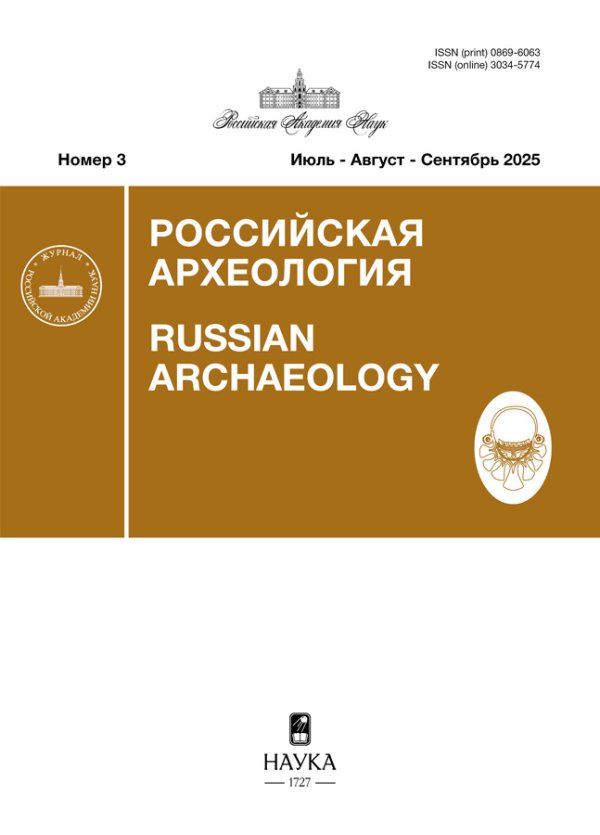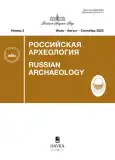Russian Archaeology
The journal has already existed for more than 50 years. It was founded in 1957 as a quarterly journal on the initiative of the head of the Moscow Archaeological School A. V. Artsikhovsky and other outstanding scholars. Before that in 1936-1959 the edition existed as a non-periodical anthology with the same title (30 volumes were issued).
The journal is aimed at professional scientists – archaeologists, historians, studying material culture, art and architecture. The journal’s chronological range is from the beginning of a human evolution to the beginning of the Modern Age, in other words to Peter the Great’s epoch (the traditional landmark in Russian archaeology).
As a fundamental scientific edition, the journal accepts only original works for publishing (such as articles, small items, books reviews, current scientific events) and also personalia (articles on the anniversaries of the famous scientists and necrologies).
Apart from the strictly scientific debates, the “Russian Archaeology” participates in the scientists’ discussion of the organization of the archaeological works, making the law on the protection of the archaeological heritage in Russia and taking part in other events on the protection of the archaeological heritage.
The journal considers unauthorized antiquities collecting as an activity that contravenes the European Charter for the Protection and Management of the Archaeological Heritage, Russian legislation and general academic views on professional ethics. Regarding the above, since 2013 only those materials are considered to be publicized which are based on the analysis of the items and contexts, received particularly as a result of legal archaeological works (on the basis of an Archaeological Excavation Permit as a special document of the government agency) or being reposed in the State Museum Fund.
Media registration certificate: № 0110154 от 04.02.1993
Current Issue
No 3 (2025)
ARTICLES
LITHIC INDUSTRIES OF THE MULTILAYERED UPPER PALAEOLITHIC SITE OF RAKHAT: CHRONOLOGY AND DYNAMICS OF DEVELOPMENT
Abstract
 7–23
7–23


PALEOLITHIC OF EASTERN TRANSBAIKALIA: CULTURAL-CHRONOLOGICAL ASPECT
Abstract
 24–36
24–36


POLLEN INDICATORS OF HUMAN IMPACT ON VEGETATION OF THE UPPER KAMA VALLEY AREA (RUSSIA) IN THE STONE AGE WITHIN THE CHASHKINSKOYE GEOARCHEOLOGICAL AREA
Abstract
 37-51
37-51


FIELD RESEARCH OF THE IRAQI-RUSSIAN ARCHAEOLOGICAL EXPEDITION AT THE SETTLEMENT OF TELL WADJEF IN SOUTHERN IRAQ (General characteristics of the settlement, its stratigraphy and elements of planigraphy)
Abstract
 52-62
52-62


THE BABINO CULTURAL CIRCLE AND EUROPEAN MIGRATION. 2200 CAL BC
Abstract
 63-78
63-78


METAL SMELTING AND CASTING AT CATACOMB SETTLEMENTS IN THE FOREST-STEPPE DON REGION
Abstract
 79–91
79–91


DYNAMICS OF PLOWING MOUNDS IN THE STEPPE ZONE BASED ON OBSERVATIONS AT 40-YEAR INTERVAL
Abstract
 92–107
92–107


ASSESSING THE POSSIBILITY OF GENOMIC STUDY OF CREMATED ARCHAEOLOGICAL SAMPLES
Abstract
 108-122
108-122


NATURAL-ANTHROPOGENIC LANDSCAPES AND LAND USE SYSTEMS IN THE UPPER PSEL BASIN IN THE IST–2ND MILLENNIA AD (based on materials from the Kurilovka 2 settlement)
Abstract
 123-139
123-139


TO THE ISSUE OF STONE MOUNDS IN PRIMORYE
Abstract
 140-152
140-152


TOMB OF PRINCESS ULIANIA OF UGLICH IN THE APSE OF SMOLENSKY CATHOLICONE FUNERARY VAULT OF MOSCOW NOVODEVICHY CONVENT
Abstract
 153–170
153–170


TO THE 70th ANNIVERSARY OF P.G. GAYDUKOV
K YuBILEYu PETRA GRIGOR'EVIChA GAYDUKOVA
 171-173
171-173


ON THE DATING OF AN OAK LOG FROM THE FORTRESS AT NOVGOROD (RYURIKOVO) GORODISHCHE
Abstract
 174-182
174-182


THE HOARD OF KUFIC COINS FOUND NEAR THE VILLAGE OF KHRUSHCHEVO-TYRNOVO
Abstract
 183-192
183-192


TWO FINDS FROM THE KNYAZHYA GORA FORTIFIED SETTLEMENT IN THE POLA RIVER BASIN
Abstract
 193-202
193-202


ON SEVERAL COUNTERFEIT WEST EUROPEAN DENARII FROM EXCAVATIONS IN VELIKY NOVGOROD
Abstract
 203-209
203-209


SPHRAGISTIC FINDS FROM EXCAVATIONS AT THE RYURIKOVO GORODISHCHE BY NOVGOROD REGIONAL EXPEDITION OF ILMK RAS IN 2015–2016 AND THEIR CONTEXT
Abstract
 210–220
210–220


SILK FABRICS AND GOLD-WOVEN RIBBONS FROM EXCAVATIONS IN STARAYA RUSSA
Abstract
 221-230
221-230


LEAD INGOTS OF THE 14TH CENTURY AD FROM VELIKY NOVGOROD IN THE CONTEXT OF THE LEAD IMPORT FROM THE SILESIAN-KRAKOW PB-ZN DEPOSITS TO RUS
Abstract
 231–246
231–246


NOVGOROD MASTERS IN MOSCOW IN 1479
Abstract
 247-251
247-251


PUBLICATIONS
ORNAMENTS MADE OF ANIMAL TEETH FROM THE ZAMIL-KOBA 1 SITE IN THE CRIMEA
Abstract
 252-264
252-264


ARTISTIC METAL FROM THE MEDIEVAL BURIAL LADEYSKOYE IN THE MIDDLE YENISEI: A COMPREHENSIVE STUDY
Abstract
 265-278
265-278


CHRONICLE
K 80-letiyu VALERIYa SERGEEVIChA FLEROVA
 279-280
279-280


K YuBILEYu VLADIMIRA YaKOVLEVIChA PETRUKhINA
 281-283
281-283












